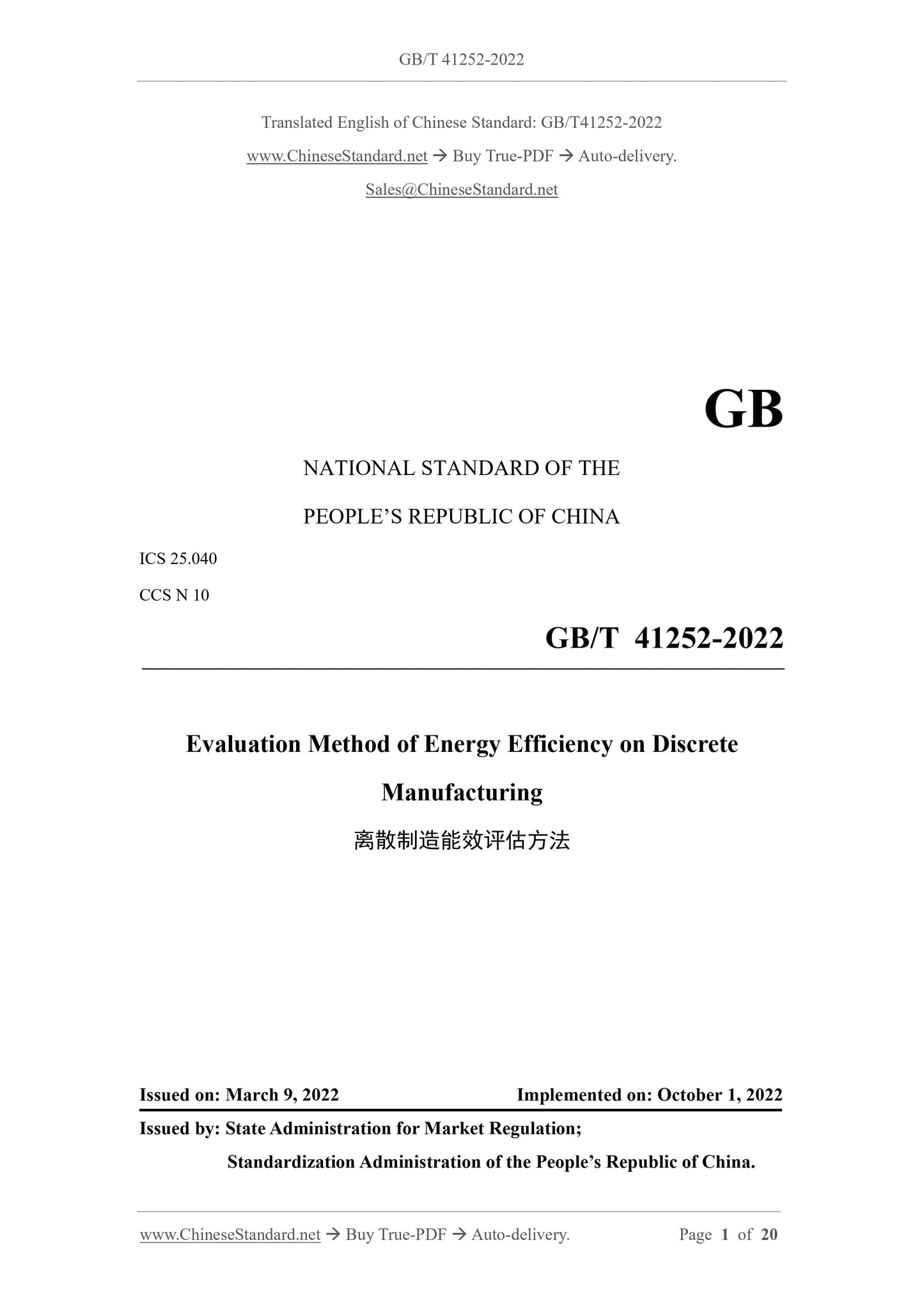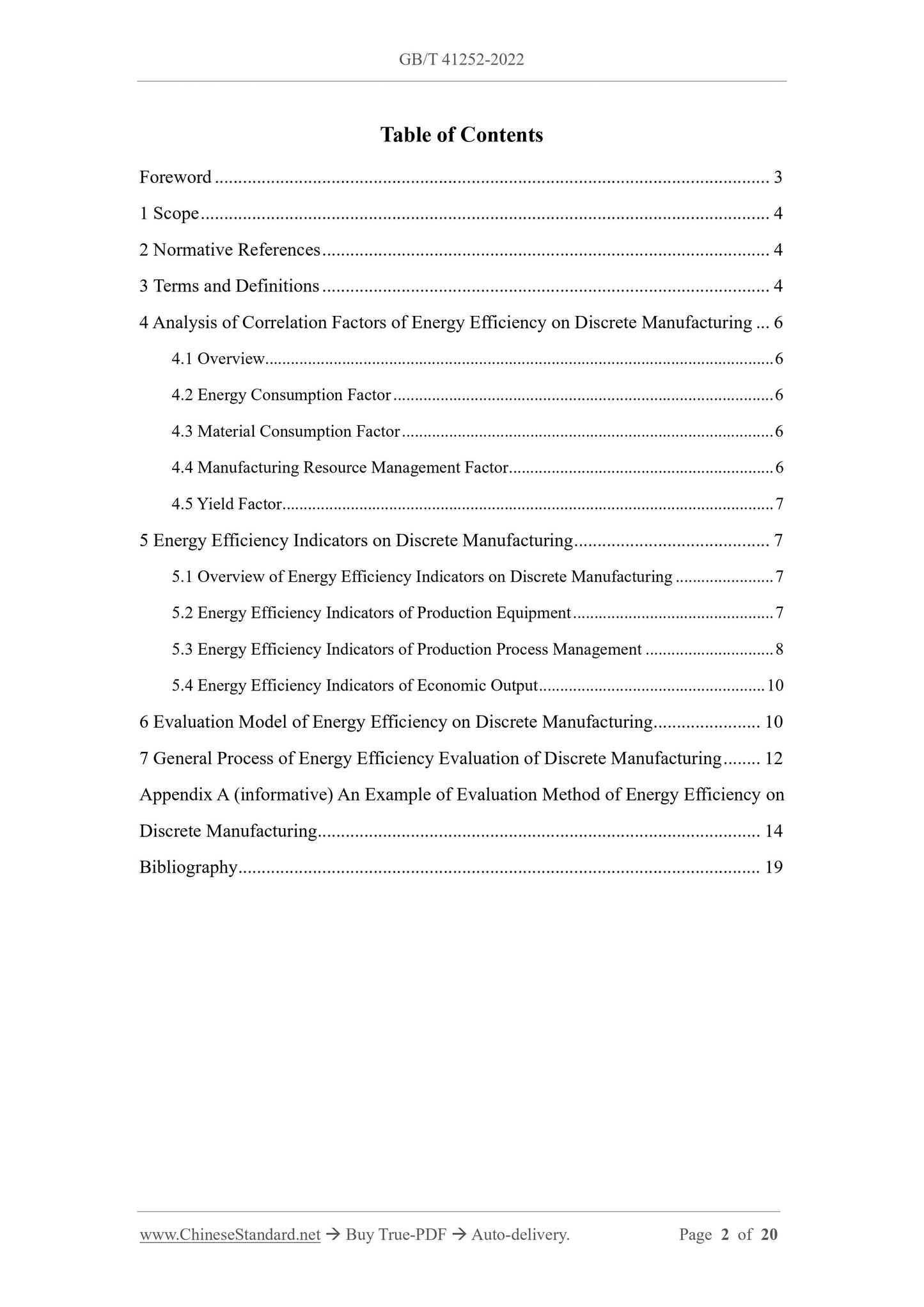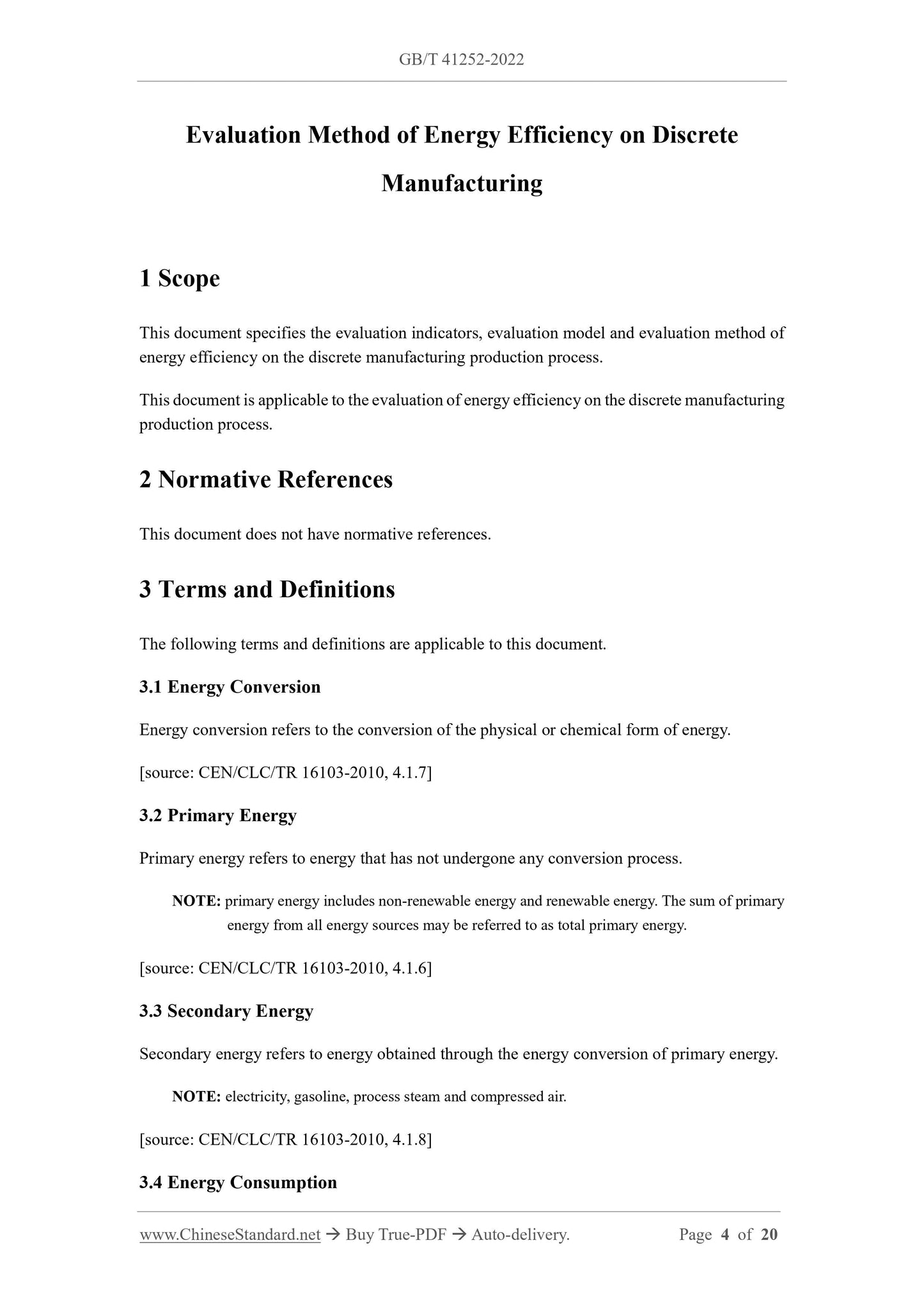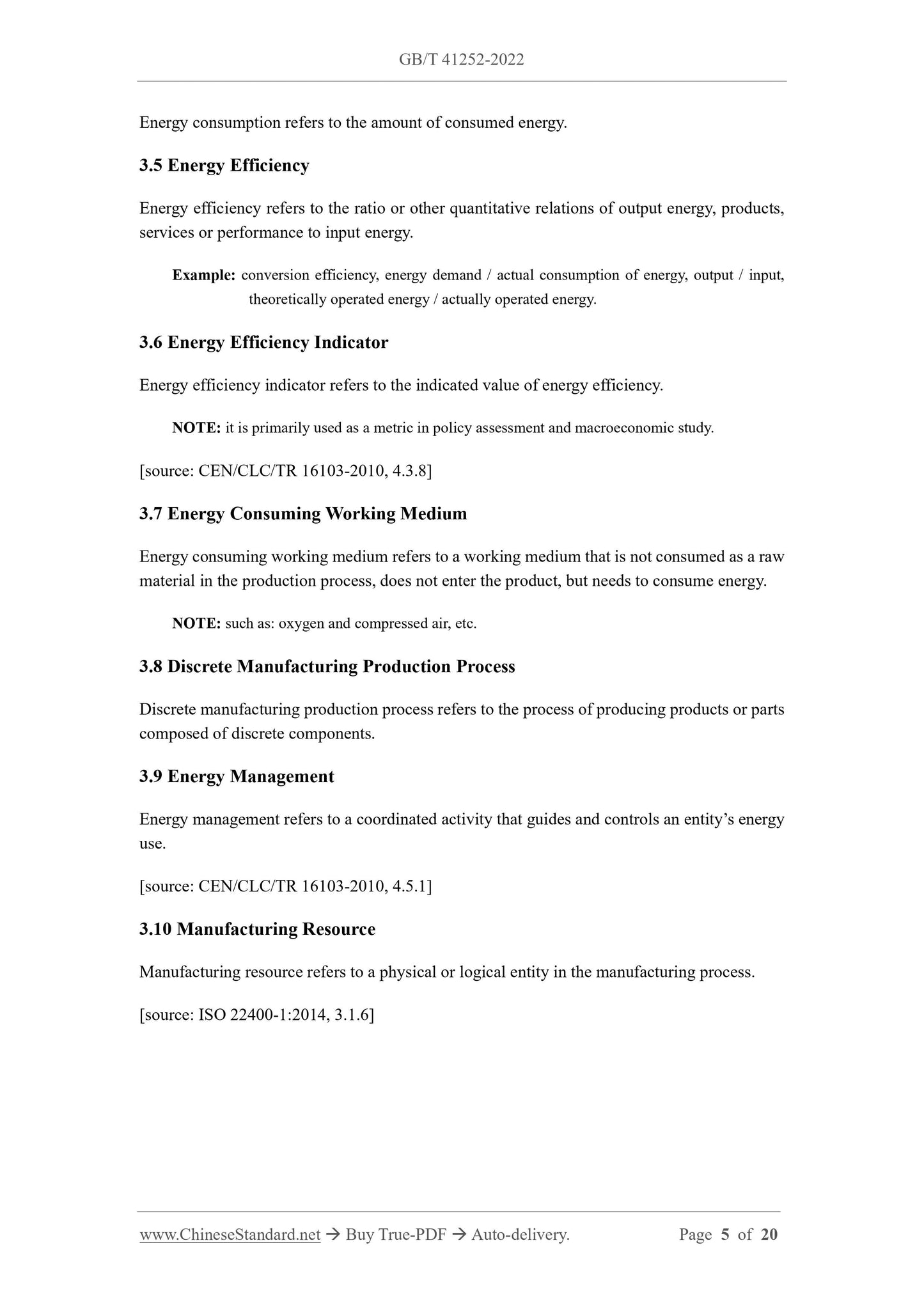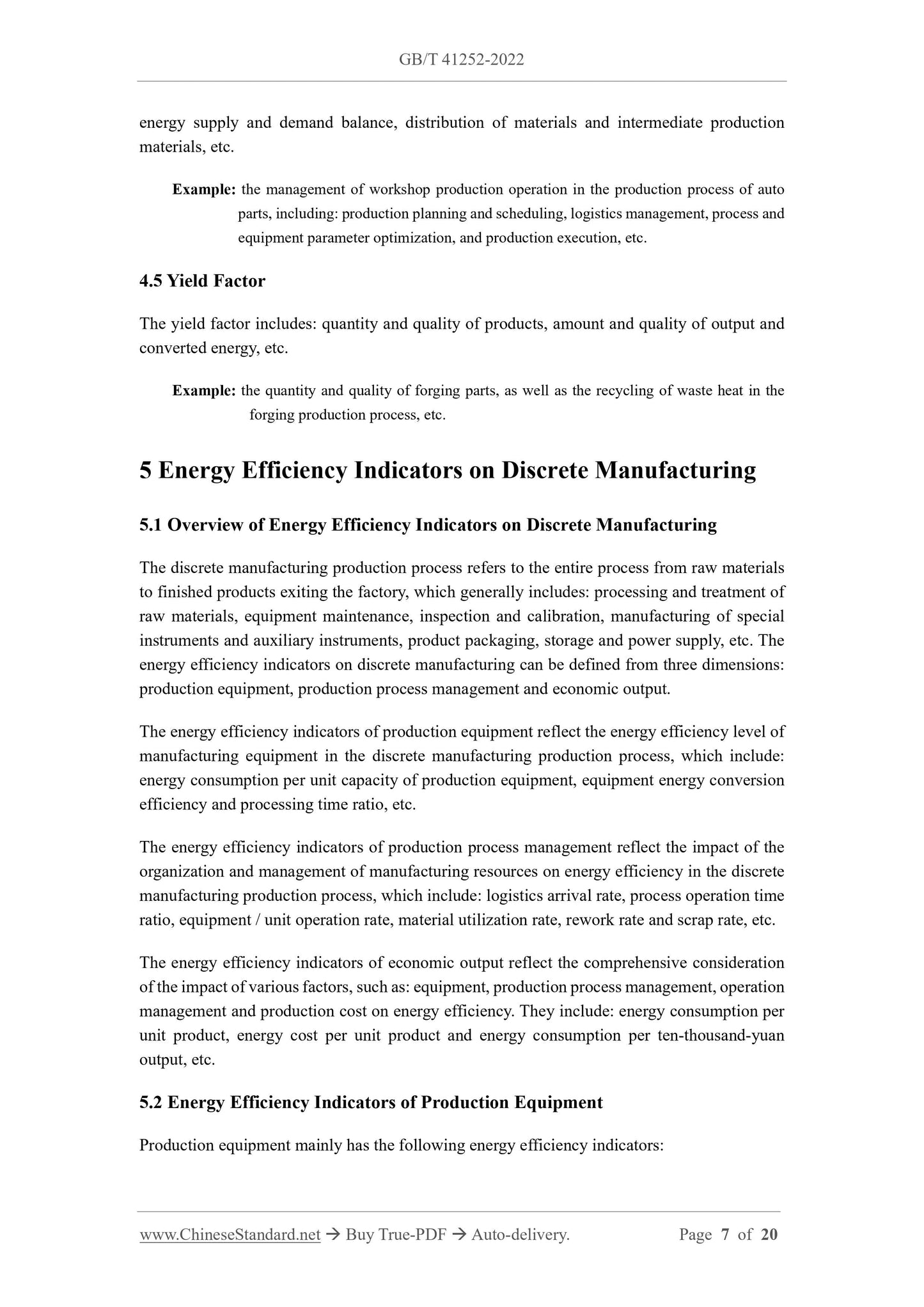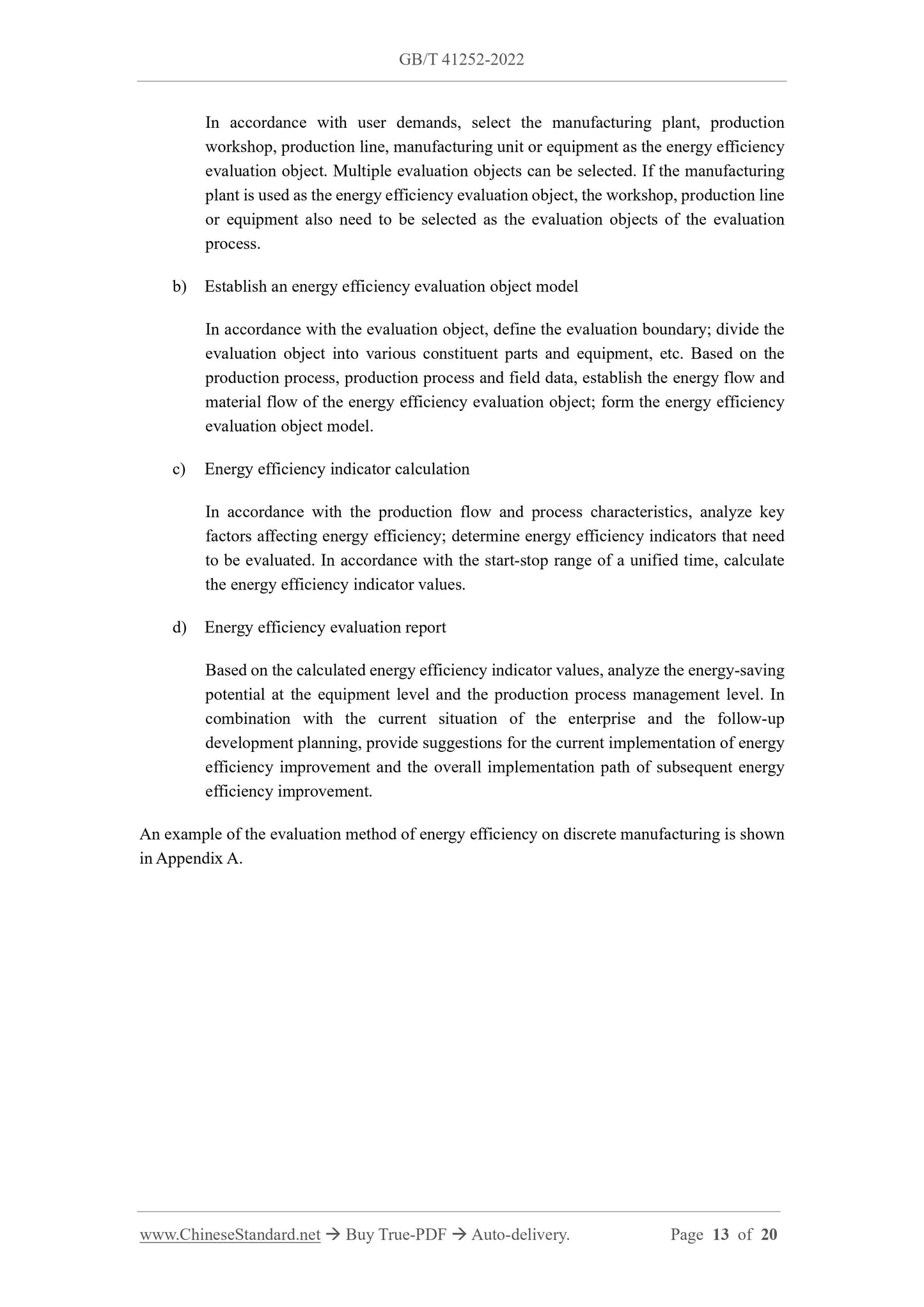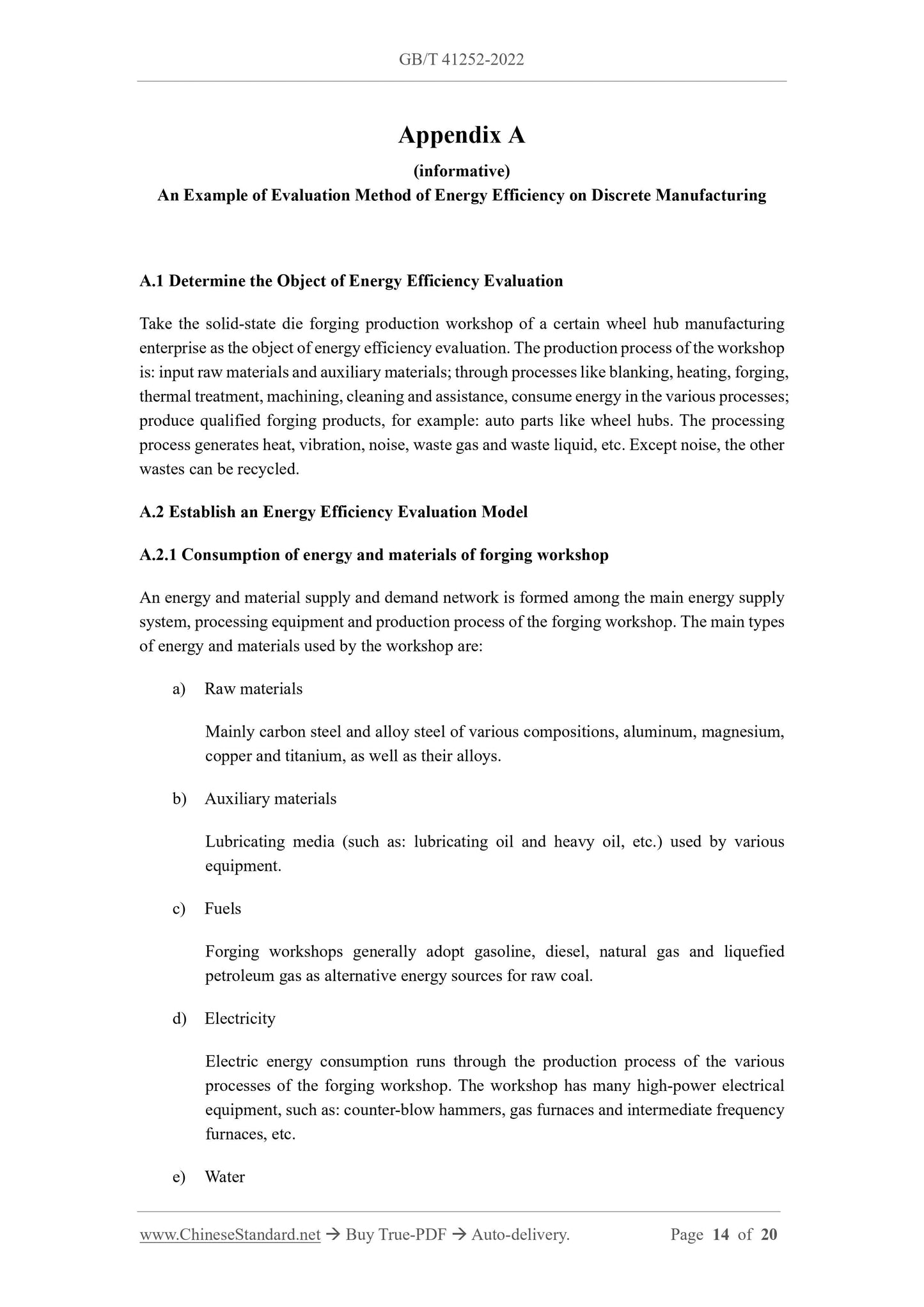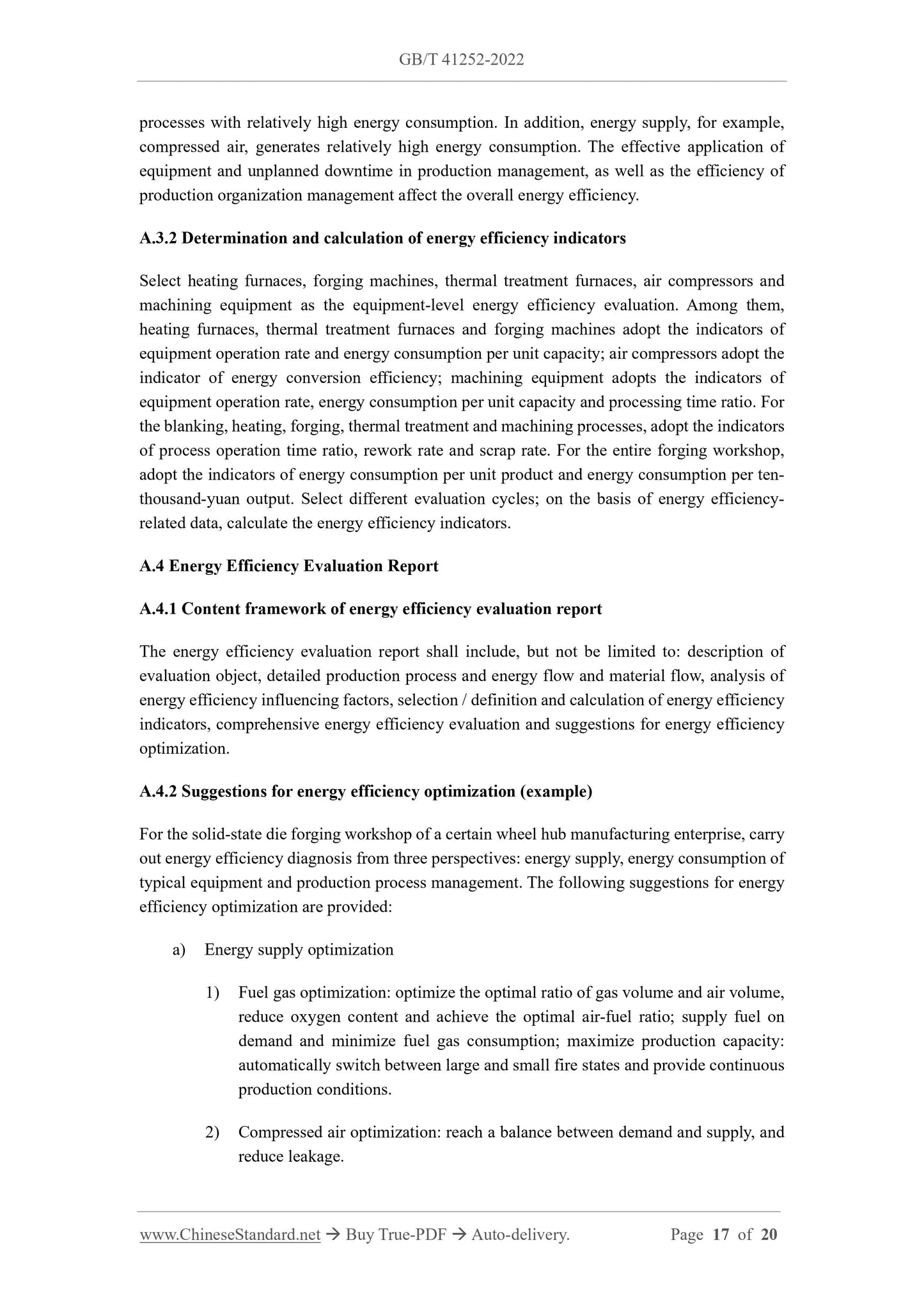1
/
of
8
www.ChineseStandard.us -- Field Test Asia Pte. Ltd.
GB/T 41252-2022 English PDF (GB/T41252-2022)
GB/T 41252-2022 English PDF (GB/T41252-2022)
Regular price
$260.00
Regular price
Sale price
$260.00
Unit price
/
per
Shipping calculated at checkout.
Couldn't load pickup availability
GB/T 41252-2022: Evaluation method of energy efficiency on discrete manufacturing
Delivery: 9 seconds. Download (& Email) true-PDF + Invoice.
Get Quotation: Click GB/T 41252-2022 (Self-service in 1-minute)
Historical versions (Master-website): GB/T 41252-2022
Preview True-PDF (Reload/Scroll-down if blank)
GB/T 41252-2022
NATIONAL STANDARD OF THE
PEOPLE’S REPUBLIC OF CHINA
ICS 25.040
CCS N 10
Evaluation Method of Energy Efficiency on Discrete
Manufacturing
ISSUED ON: MARCH 9, 2022
IMPLEMENTED ON: OCTOBER 1, 2022
Issued by: State Administration for Market Regulation;
Standardization Administration of the People’s Republic of China.
Table of Contents
Foreword ... 3
1 Scope ... 4
2 Normative References ... 4
3 Terms and Definitions ... 4
4 Analysis of Correlation Factors of Energy Efficiency on Discrete Manufacturing ... 6
4.1 Overview ... 6
4.2 Energy Consumption Factor ... 6
4.3 Material Consumption Factor ... 6
4.4 Manufacturing Resource Management Factor ... 6
4.5 Yield Factor ... 7
5 Energy Efficiency Indicators on Discrete Manufacturing ... 7
5.1 Overview of Energy Efficiency Indicators on Discrete Manufacturing ... 7
5.2 Energy Efficiency Indicators of Production Equipment ... 7
5.3 Energy Efficiency Indicators of Production Process Management ... 8
5.4 Energy Efficiency Indicators of Economic Output ... 10
6 Evaluation Model of Energy Efficiency on Discrete Manufacturing ... 10
7 General Process of Energy Efficiency Evaluation of Discrete Manufacturing ... 12
Appendix A (informative) An Example of Evaluation Method of Energy Efficiency on
Discrete Manufacturing ... 14
Bibliography ... 19
Evaluation Method of Energy Efficiency on Discrete
Manufacturing
1 Scope
This document specifies the evaluation indicators, evaluation model and evaluation method of
energy efficiency on the discrete manufacturing production process.
This document is applicable to the evaluation of energy efficiency on the discrete manufacturing
production process.
2 Normative References
This document does not have normative references.
3 Terms and Definitions
The following terms and definitions are applicable to this document.
3.1 Energy Conversion
Energy conversion refers to the conversion of the physical or chemical form of energy.
[source: CEN/CLC/TR 16103-2010, 4.1.7]
3.2 Primary Energy
Primary energy refers to energy that has not undergone any conversion process.
NOTE: primary energy includes non-renewable energy and renewable energy. The sum of primary
energy from all energy sources may be referred to as total primary energy.
[source: CEN/CLC/TR 16103-2010, 4.1.6]
3.3 Secondary Energy
Secondary energy refers to energy obtained through the energy conversion of primary energy.
NOTE: electricity, gasoline, process steam and compressed air.
[source: CEN/CLC/TR 16103-2010, 4.1.8]
3.4 Energy Consumption
Energy consumption refers to the amount of consumed energy.
3.5 Energy Efficiency
Energy efficiency refers to the ratio or other quantitative relations of output energy, products,
services or performance to input energy.
Example: conversion efficiency, energy demand / actual consumption of energy, output / input,
theoretically operated energy / actually operated energy.
3.6 Energy Efficiency Indicator
Energy efficiency indicator refers to the indicated value of energy efficiency.
NOTE: it is primarily used as a metric in policy assessment and macroeconomic study.
[source: CEN/CLC/TR 16103-2010, 4.3.8]
3.7 Energy Consuming Working Medium
Energy consuming working medium refers to a working medium that is not consumed as a raw
material in the production process, does not enter the product, but needs to consume energy.
NOTE: such as: oxygen and compressed air, etc.
3.8 Discrete Manufacturing Production Process
Discrete manufacturing production process refers to the process of producing products or parts
composed of discrete components.
3.9 Energy Management
Energy management refers to a coordinated activity that guides and controls an entity’s energy
use.
[source: CEN/CLC/TR 16103-2010, 4.5.1]
3.10 Manufacturing Resource
Manufacturing resource refers to a physical or logical entity in the manufacturing process.
[source: ISO 22400-1:2014, 3.1.6]
energy supply and demand balance, distribution of materials and intermediate production
materials, etc.
Example: the management of workshop production operation in the production process of auto
parts, including: production planning and scheduling, logistics management, process and
equipment parameter optimization, and production execution, etc.
4.5 Yield Factor
The yield factor includes: quantity and quality of products, amount and quality of output and
converted energy, etc.
Example: the quantity and quality of forging parts, as well as the recycling of waste heat in the
forging production process, etc.
5 Energy Efficiency Indicators on Discrete Manufacturing
5.1 Overview of Energy Efficiency Indicators on Discrete Manufacturing
The discrete manufacturing production process refers to the entire process from raw materials
to finished products exiting the factory, which generally includes: processing and treatment of
raw materials, equipment maintenance, inspection and calibration, manufacturing of special
instruments and auxiliary instruments, product packaging, storage and power supply, etc. The
energy efficiency indicators on discrete manufacturing can be defined from three dimensions:
production equipment, production process management and economic output.
The energy efficiency indicators of production equipment reflect the energy efficiency level of
manufacturing equipment in the discrete manufacturing production process, which include:
energy consumption per unit capacity of production equipment, equipment energy conversion
efficiency and processing time ratio, etc.
The energy efficiency indicators of production process management reflect the impact of the
organization and management of manufacturing resources on energy efficiency in the discrete
manufacturing production process, which include: logistics arrival rate, process operation time
ratio, equipment / unit operation rate, material utilization rate, rework rate and scrap rate, etc.
The energy efficiency indicators of economic output reflect the comprehensive consideration
of the impact of various factors, such as: equipment, production process management, operation
management and production cost on energy efficiency. They include: energy consumption per
unit product, energy cost per unit product and energy consumption per ten-thousand-yuan
output, etc.
5.2 Energy Efficiency Indicators of Production Equipment
Production equipment mainly has the following energy efficiency indicators:
In accordance with user demands, select the manufacturing plant, production
workshop, production line, manufacturing unit or equipment as the energy efficiency
evaluation object. Multiple evaluation objects can be selected. If the manufacturing
plant is used as the energy efficiency evaluation object, the workshop, production line
or equipment also need to be selected as the evaluation objects of the evaluation
process.
b) Establish an energy efficiency evaluation object model
In accordance with the evaluation object, define the evaluation boundary; divide the
evaluation object into various constituent parts and equipment, etc. Based on the
production process, production process and field data, establish the energy flow and
material flow of the energy efficiency evaluation object; form the energy efficiency
evaluation object model.
c) Energy efficiency indicator calculation
In accordance with the production flow and process characteristics, analyze key
factors affecting energy efficiency; determine energy efficiency indicators that need
to be evaluated. In accordance with the start-stop range of a unified time, calculate
the energy efficiency indicator values.
d) Energy efficiency evaluation report
Based on the calculated energy efficiency indicator values, analyze the energy-saving
potential at the equipment level and the production process management level. In
combination with the current situation of the enterprise and the follow-up
development planning, provide suggestions for the current implementation of energy
efficiency improvement and the overall implementation path of subsequent energy
efficiency improvement.
An example of the evaluation method of energy efficiency on discrete manufacturing is shown
in Appendix A.
Appendix A
(informative)
An Example of Evaluation Method of Energy Efficiency on Discrete Manufacturing
A.1 Determine the Object of Energy Efficiency Evaluation
Take the solid-state die forging production workshop of a certain wheel hub manufacturing
enterprise as the object of energy efficiency evaluation. The production process of the workshop
is: input raw materials and auxiliary materials; through processes like blanking, heating, forging,
thermal treatment, machining, cleaning and assistance, consume energy in the various processes;
produce qualified forging products, for example: auto parts like wheel hubs. The processing
process generates heat, vibration, noise, waste gas and waste liquid, etc. Except noise, the other
wastes can be recycled.
A.2 Establish an Energy Efficiency Evaluation Model
A.2.1 Consumption of energy and materials of forging workshop
An energy and material supply and demand network is formed among the main energy supply
system, processing equipment and production process of the forging workshop. The main types
of energy and materials used by the workshop are:
a) Raw materials
Mainly carbon steel and alloy steel of various compositions, aluminum, magnesium,
copper and titanium, as well as their alloys.
b) Auxiliary materials
Lubricating media (such as: lubricating oil and heavy oil, etc.) used by various
equipment.
c) Fuels
Forging workshops generally adopt gasoline, diesel, natural gas and liquefied
petroleum gas as alternative energy sources for raw coal.
d) Electricity
Electric energy consumption runs through the production process of the various
processes of the forging workshop. The workshop has many high-power electrical
equipment, such as: counter-blow hammers, gas furnaces and intermediate frequency
furnaces, etc.
e) Water
processes with relatively high energy consumption. In addition, energy supply, for example,
compressed air, generates relatively high energy consumption. The effective application of
equipment and unplanned downtime in production management, as well as the efficiency of
production organization management affect the overall energy efficiency.
A.3.2 Determination and calculation of energy efficiency indicators
Select heating furnaces, forging machines, thermal treatment furnaces, air compressors and
machining equipment as the equipment-level energy efficiency evaluation. Among them,
heating furnaces, thermal treatment furnaces and forging machines adopt the indicators of
equipment operation rate and energy consumption per unit capacity; air compressors adopt the
indicator of energy conversion efficiency; machining equipment adopts the indicators of
equipment operation rate, energy consumption per unit capacity and processing time ratio. For
the blanking, heating, forging, thermal treatment and machining processes, adopt the indicators
of process operation time ratio, rework rate and scrap rate. For the entire forging workshop,
adopt the indicators of energy consumption per unit product and energy consumption per ten-
thousand-yuan output. Select different evaluation cycles; on the basis of energy efficiency-
related data, calculate the energy efficiency indicators.
A.4 Energy Efficiency Evaluation Report
A.4.1 Content framework of energy efficiency evaluation report
The energy efficiency evaluation report shall include, but not be limited to: description of
evaluation object, detailed production process and energy flow and material flow, analysis of
energy efficiency influencing factors, selection / definition and calculation of energy efficiency
indicators, comprehensive energy efficiency evaluation and suggestions for energy efficiency
optimization.
A.4.2 Suggestions for energy efficiency optimization (example)
For the solid-state die forging workshop of a certain wheel hub manufacturing enterprise, carry
out energy efficiency diagnosis from three perspectives: energy supply, energy consumption of
typical equipment and production process management. The following suggestions for energy
efficiency optimization are provided:
a) Energy supply optimization
1) Fuel gas optimization: optimize the optimal ratio of gas volume and air volume,
reduce oxygen content and achieve the optimal air-fuel ratio; supply fuel on
demand and minimize fuel gas consumption; maximize production capacity:
automatically switch between large and small fire states and provide continuous
production conditions.
2) Compressed air optimization: reach a balance between demand and supply, and
reduce leakage.
GB/T 41252-2022
NATIONAL STANDARD OF THE
PEOPLE’S REPUBLIC OF CHINA
ICS 25.040
CCS N 10
Evaluation Method of Energy Efficiency on Discrete
Manufacturing
ISSUED ON: MARCH 9, 2022
IMPLEMENTED ON: OCTOBER 1, 2022
Issued by: State Administration for Market Regulation;
Standardization Administration of the People’s Republic of China.
Table of Contents
Foreword ... 3
1 Scope ... 4
2 Normative References ... 4
3 Terms and Definitions ... 4
4 Analysis of Correlation Factors of Energy Efficiency on Discrete Manufacturing ... 6
4.1 Overview ... 6
4.2 Energy Consumption Factor ... 6
4.3 Material Consumption Factor ... 6
4.4 Manufacturing Resource Management Factor ... 6
4.5 Yield Factor ... 7
5 Energy Efficiency Indicators on Discrete Manufacturing ... 7
5.1 Overview of Energy Efficiency Indicators on Discrete Manufacturing ... 7
5.2 Energy Efficiency Indicators of Production Equipment ... 7
5.3 Energy Efficiency Indicators of Production Process Management ... 8
5.4 Energy Efficiency Indicators of Economic Output ... 10
6 Evaluation Model of Energy Efficiency on Discrete Manufacturing ... 10
7 General Process of Energy Efficiency Evaluation of Discrete...
Delivery: 9 seconds. Download (& Email) true-PDF + Invoice.
Get Quotation: Click GB/T 41252-2022 (Self-service in 1-minute)
Historical versions (Master-website): GB/T 41252-2022
Preview True-PDF (Reload/Scroll-down if blank)
GB/T 41252-2022
NATIONAL STANDARD OF THE
PEOPLE’S REPUBLIC OF CHINA
ICS 25.040
CCS N 10
Evaluation Method of Energy Efficiency on Discrete
Manufacturing
ISSUED ON: MARCH 9, 2022
IMPLEMENTED ON: OCTOBER 1, 2022
Issued by: State Administration for Market Regulation;
Standardization Administration of the People’s Republic of China.
Table of Contents
Foreword ... 3
1 Scope ... 4
2 Normative References ... 4
3 Terms and Definitions ... 4
4 Analysis of Correlation Factors of Energy Efficiency on Discrete Manufacturing ... 6
4.1 Overview ... 6
4.2 Energy Consumption Factor ... 6
4.3 Material Consumption Factor ... 6
4.4 Manufacturing Resource Management Factor ... 6
4.5 Yield Factor ... 7
5 Energy Efficiency Indicators on Discrete Manufacturing ... 7
5.1 Overview of Energy Efficiency Indicators on Discrete Manufacturing ... 7
5.2 Energy Efficiency Indicators of Production Equipment ... 7
5.3 Energy Efficiency Indicators of Production Process Management ... 8
5.4 Energy Efficiency Indicators of Economic Output ... 10
6 Evaluation Model of Energy Efficiency on Discrete Manufacturing ... 10
7 General Process of Energy Efficiency Evaluation of Discrete Manufacturing ... 12
Appendix A (informative) An Example of Evaluation Method of Energy Efficiency on
Discrete Manufacturing ... 14
Bibliography ... 19
Evaluation Method of Energy Efficiency on Discrete
Manufacturing
1 Scope
This document specifies the evaluation indicators, evaluation model and evaluation method of
energy efficiency on the discrete manufacturing production process.
This document is applicable to the evaluation of energy efficiency on the discrete manufacturing
production process.
2 Normative References
This document does not have normative references.
3 Terms and Definitions
The following terms and definitions are applicable to this document.
3.1 Energy Conversion
Energy conversion refers to the conversion of the physical or chemical form of energy.
[source: CEN/CLC/TR 16103-2010, 4.1.7]
3.2 Primary Energy
Primary energy refers to energy that has not undergone any conversion process.
NOTE: primary energy includes non-renewable energy and renewable energy. The sum of primary
energy from all energy sources may be referred to as total primary energy.
[source: CEN/CLC/TR 16103-2010, 4.1.6]
3.3 Secondary Energy
Secondary energy refers to energy obtained through the energy conversion of primary energy.
NOTE: electricity, gasoline, process steam and compressed air.
[source: CEN/CLC/TR 16103-2010, 4.1.8]
3.4 Energy Consumption
Energy consumption refers to the amount of consumed energy.
3.5 Energy Efficiency
Energy efficiency refers to the ratio or other quantitative relations of output energy, products,
services or performance to input energy.
Example: conversion efficiency, energy demand / actual consumption of energy, output / input,
theoretically operated energy / actually operated energy.
3.6 Energy Efficiency Indicator
Energy efficiency indicator refers to the indicated value of energy efficiency.
NOTE: it is primarily used as a metric in policy assessment and macroeconomic study.
[source: CEN/CLC/TR 16103-2010, 4.3.8]
3.7 Energy Consuming Working Medium
Energy consuming working medium refers to a working medium that is not consumed as a raw
material in the production process, does not enter the product, but needs to consume energy.
NOTE: such as: oxygen and compressed air, etc.
3.8 Discrete Manufacturing Production Process
Discrete manufacturing production process refers to the process of producing products or parts
composed of discrete components.
3.9 Energy Management
Energy management refers to a coordinated activity that guides and controls an entity’s energy
use.
[source: CEN/CLC/TR 16103-2010, 4.5.1]
3.10 Manufacturing Resource
Manufacturing resource refers to a physical or logical entity in the manufacturing process.
[source: ISO 22400-1:2014, 3.1.6]
energy supply and demand balance, distribution of materials and intermediate production
materials, etc.
Example: the management of workshop production operation in the production process of auto
parts, including: production planning and scheduling, logistics management, process and
equipment parameter optimization, and production execution, etc.
4.5 Yield Factor
The yield factor includes: quantity and quality of products, amount and quality of output and
converted energy, etc.
Example: the quantity and quality of forging parts, as well as the recycling of waste heat in the
forging production process, etc.
5 Energy Efficiency Indicators on Discrete Manufacturing
5.1 Overview of Energy Efficiency Indicators on Discrete Manufacturing
The discrete manufacturing production process refers to the entire process from raw materials
to finished products exiting the factory, which generally includes: processing and treatment of
raw materials, equipment maintenance, inspection and calibration, manufacturing of special
instruments and auxiliary instruments, product packaging, storage and power supply, etc. The
energy efficiency indicators on discrete manufacturing can be defined from three dimensions:
production equipment, production process management and economic output.
The energy efficiency indicators of production equipment reflect the energy efficiency level of
manufacturing equipment in the discrete manufacturing production process, which include:
energy consumption per unit capacity of production equipment, equipment energy conversion
efficiency and processing time ratio, etc.
The energy efficiency indicators of production process management reflect the impact of the
organization and management of manufacturing resources on energy efficiency in the discrete
manufacturing production process, which include: logistics arrival rate, process operation time
ratio, equipment / unit operation rate, material utilization rate, rework rate and scrap rate, etc.
The energy efficiency indicators of economic output reflect the comprehensive consideration
of the impact of various factors, such as: equipment, production process management, operation
management and production cost on energy efficiency. They include: energy consumption per
unit product, energy cost per unit product and energy consumption per ten-thousand-yuan
output, etc.
5.2 Energy Efficiency Indicators of Production Equipment
Production equipment mainly has the following energy efficiency indicators:
In accordance with user demands, select the manufacturing plant, production
workshop, production line, manufacturing unit or equipment as the energy efficiency
evaluation object. Multiple evaluation objects can be selected. If the manufacturing
plant is used as the energy efficiency evaluation object, the workshop, production line
or equipment also need to be selected as the evaluation objects of the evaluation
process.
b) Establish an energy efficiency evaluation object model
In accordance with the evaluation object, define the evaluation boundary; divide the
evaluation object into various constituent parts and equipment, etc. Based on the
production process, production process and field data, establish the energy flow and
material flow of the energy efficiency evaluation object; form the energy efficiency
evaluation object model.
c) Energy efficiency indicator calculation
In accordance with the production flow and process characteristics, analyze key
factors affecting energy efficiency; determine energy efficiency indicators that need
to be evaluated. In accordance with the start-stop range of a unified time, calculate
the energy efficiency indicator values.
d) Energy efficiency evaluation report
Based on the calculated energy efficiency indicator values, analyze the energy-saving
potential at the equipment level and the production process management level. In
combination with the current situation of the enterprise and the follow-up
development planning, provide suggestions for the current implementation of energy
efficiency improvement and the overall implementation path of subsequent energy
efficiency improvement.
An example of the evaluation method of energy efficiency on discrete manufacturing is shown
in Appendix A.
Appendix A
(informative)
An Example of Evaluation Method of Energy Efficiency on Discrete Manufacturing
A.1 Determine the Object of Energy Efficiency Evaluation
Take the solid-state die forging production workshop of a certain wheel hub manufacturing
enterprise as the object of energy efficiency evaluation. The production process of the workshop
is: input raw materials and auxiliary materials; through processes like blanking, heating, forging,
thermal treatment, machining, cleaning and assistance, consume energy in the various processes;
produce qualified forging products, for example: auto parts like wheel hubs. The processing
process generates heat, vibration, noise, waste gas and waste liquid, etc. Except noise, the other
wastes can be recycled.
A.2 Establish an Energy Efficiency Evaluation Model
A.2.1 Consumption of energy and materials of forging workshop
An energy and material supply and demand network is formed among the main energy supply
system, processing equipment and production process of the forging workshop. The main types
of energy and materials used by the workshop are:
a) Raw materials
Mainly carbon steel and alloy steel of various compositions, aluminum, magnesium,
copper and titanium, as well as their alloys.
b) Auxiliary materials
Lubricating media (such as: lubricating oil and heavy oil, etc.) used by various
equipment.
c) Fuels
Forging workshops generally adopt gasoline, diesel, natural gas and liquefied
petroleum gas as alternative energy sources for raw coal.
d) Electricity
Electric energy consumption runs through the production process of the various
processes of the forging workshop. The workshop has many high-power electrical
equipment, such as: counter-blow hammers, gas furnaces and intermediate frequency
furnaces, etc.
e) Water
processes with relatively high energy consumption. In addition, energy supply, for example,
compressed air, generates relatively high energy consumption. The effective application of
equipment and unplanned downtime in production management, as well as the efficiency of
production organization management affect the overall energy efficiency.
A.3.2 Determination and calculation of energy efficiency indicators
Select heating furnaces, forging machines, thermal treatment furnaces, air compressors and
machining equipment as the equipment-level energy efficiency evaluation. Among them,
heating furnaces, thermal treatment furnaces and forging machines adopt the indicators of
equipment operation rate and energy consumption per unit capacity; air compressors adopt the
indicator of energy conversion efficiency; machining equipment adopts the indicators of
equipment operation rate, energy consumption per unit capacity and processing time ratio. For
the blanking, heating, forging, thermal treatment and machining processes, adopt the indicators
of process operation time ratio, rework rate and scrap rate. For the entire forging workshop,
adopt the indicators of energy consumption per unit product and energy consumption per ten-
thousand-yuan output. Select different evaluation cycles; on the basis of energy efficiency-
related data, calculate the energy efficiency indicators.
A.4 Energy Efficiency Evaluation Report
A.4.1 Content framework of energy efficiency evaluation report
The energy efficiency evaluation report shall include, but not be limited to: description of
evaluation object, detailed production process and energy flow and material flow, analysis of
energy efficiency influencing factors, selection / definition and calculation of energy efficiency
indicators, comprehensive energy efficiency evaluation and suggestions for energy efficiency
optimization.
A.4.2 Suggestions for energy efficiency optimization (example)
For the solid-state die forging workshop of a certain wheel hub manufacturing enterprise, carry
out energy efficiency diagnosis from three perspectives: energy supply, energy consumption of
typical equipment and production process management. The following suggestions for energy
efficiency optimization are provided:
a) Energy supply optimization
1) Fuel gas optimization: optimize the optimal ratio of gas volume and air volume,
reduce oxygen content and achieve the optimal air-fuel ratio; supply fuel on
demand and minimize fuel gas consumption; maximize production capacity:
automatically switch between large and small fire states and provide continuous
production conditions.
2) Compressed air optimization: reach a balance between demand and supply, and
reduce leakage.
GB/T 41252-2022
NATIONAL STANDARD OF THE
PEOPLE’S REPUBLIC OF CHINA
ICS 25.040
CCS N 10
Evaluation Method of Energy Efficiency on Discrete
Manufacturing
ISSUED ON: MARCH 9, 2022
IMPLEMENTED ON: OCTOBER 1, 2022
Issued by: State Administration for Market Regulation;
Standardization Administration of the People’s Republic of China.
Table of Contents
Foreword ... 3
1 Scope ... 4
2 Normative References ... 4
3 Terms and Definitions ... 4
4 Analysis of Correlation Factors of Energy Efficiency on Discrete Manufacturing ... 6
4.1 Overview ... 6
4.2 Energy Consumption Factor ... 6
4.3 Material Consumption Factor ... 6
4.4 Manufacturing Resource Management Factor ... 6
4.5 Yield Factor ... 7
5 Energy Efficiency Indicators on Discrete Manufacturing ... 7
5.1 Overview of Energy Efficiency Indicators on Discrete Manufacturing ... 7
5.2 Energy Efficiency Indicators of Production Equipment ... 7
5.3 Energy Efficiency Indicators of Production Process Management ... 8
5.4 Energy Efficiency Indicators of Economic Output ... 10
6 Evaluation Model of Energy Efficiency on Discrete Manufacturing ... 10
7 General Process of Energy Efficiency Evaluation of Discrete...
Share
